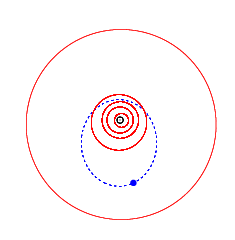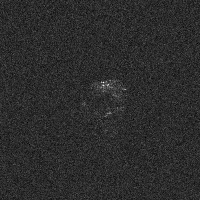Related Research Articles
3352 McAuliffe, provisional designation 1981 CW, is a rare-type asteroid and suspected binary system, classified as near-Earth object of the Amor group, approximately 2 kilometers in diameter. It was discovered on 6 February 1981, by American astronomer Norman Thomas at Lowell's Anderson Mesa Station near Flagstaff, Arizona, United States.
2340 Hathor, provisional designation 1976 UA, is an eccentric stony asteroid, classified as near-Earth object and potentially hazardous asteroid. It belongs to the Aten group of asteroids and measures approximately 210 meters in diameter. Discovered by Charles Kowal in 1976, it was later named after the ancient Egyptian goddess Hathor.
(12538) 1998 OH is a stony asteroid, classified as near-Earth object and potentially hazardous asteroid of the Apollo group, approximately 1.8 kilometers in diameter. It was discovered on 19 July 1998, by astronomers of the Near-Earth Asteroid Tracking program at the Haleakala Observatory in Hawaii, United States. This minor planet was numbered by the Minor Planet Center on 23 November 1999. As of 2018, it has not been named. In 2019, the asteroid came within about 73 lunar distances of Earth.

9950 ESA, provisional designation 1990 VB, is an eccentric asteroid and elongated near-Earth object of the Amor group, approximately 1.7 kilometers in diameter. It was discovered on 8 November 1990, by French astronomer Christian Pollas at the Centre de recherches en géodynamique et astrométrie (Cerga) at Caussols in southeastern France. It was named for the European Space Agency (ESA).
4401 Aditi is an eccentric, stony asteroid, classified as a near-Earth object and Amor asteroid, approximately 1.8 kilometers in diameter. It was discovered on 14 October 1985 by American astronomer Carolyn Shoemaker at Palomar Observatory in California, and later named after the Hindu goddess Aditi.
4450 Pan is a highly eccentric asteroid and contact binary, classified as a potentially hazardous asteroid and near-Earth object of the Apollo group, approximately 1.1 kilometers in diameter. It was discovered on 25 September 1987, by American astronomers Eugene and Carolyn Shoemaker at Palomar Observatory in California, United States. It was named after Pan from Greek mythology.
26074 Carlwirtz is a dynamical Hungaria asteroid and binary Mars-crosser from the innermost regions of the asteroid belt, approximately 3 kilometers in diameter. It was discovered on 8 October 1977, by German astronomer Hans-Emil Schuster at ESO's La Silla Observatory in northern Chile. The likely binary asteroid on a relatively circular orbit has a short rotation period of 2.5 hours. It was named for German astronomer Carl Wilhelm Wirtz. The system's suspected minor-planet moon of unknown size was first detected in 2013.
1864 Daedalus, provisional designation 1971 FA, is a stony asteroid and near-Earth object of the Apollo group, approximately 3 kilometers in diameter. It was discovered on 24 March 1971, by Dutch–American astronomer Tom Gehrels at Palomar Observatory, California, and named after Daedalus from Greek mythology.
8013 Gordonmoore, provisional designation 1990 KA, is an eccentric, stony asteroid and near-Earth object of the Apollo group, approximately 1–2 kilometers in diameter.
(467336) 2002 LT38, is a sub-kilometer asteroid and suspected tumbler, classified as a near-Earth object and potentially hazardous asteroid of the Aten group, approximately 240 meters (790 ft) in diameter. It was discovered on 12 June 2002, by astronomers of the Lincoln Near-Earth Asteroid Research at the Lincoln Laboratory's Experimental Test Site near Socorro, New Mexico, in the United States.
(416151) 2002 RQ25 is a carbonaceous asteroid of the Apollo group, classified as near-Earth object and potentially hazardous asteroid, approximately 0.2 kilometers in diameter. It was discovered on 3 September 2002, by the Campo Imperatore Near-Earth Object Survey (CINEOS) at the Italian Campo Imperatore Observatory, located in the Abruzzo region, east of Rome.
(471240) 2011 BT15, provisional designation 2011 BT15, is a stony, sub-kilometer sized asteroid and fast rotator, classified as a near-Earth object and potentially hazardous asteroid of the Apollo group. It had been one of the objects with the highest impact threat on the Palermo Technical Impact Hazard Scale.
(86039) 1999 NC43 (provisional designation 1999 NC43) is an asteroid on an eccentric orbit, classified as near-Earth object and potentially hazardous asteroid of the Apollo group, approximately 2 kilometers in diameter. This suspected tumbler and relatively slow rotator was discovered by LINEAR in 1999.

(436724) 2011 UW158, provisionally known as 2011 UW158, is a stony, walnut-shaped asteroid and fast rotator, classified as near-Earth object and potentially hazardous asteroid of the Apollo group, approximately 300 meters in diameter. It was discovered on 25 October 2011, by Pan-STARRS at Haleakala Observatory on the island of Maui, Hawaii, in the United States.

(190166) 2005 UP156 is a stony asteroid and binary system, classified as near-Earth object of the Apollo group, approximately 1 kilometer in diameter. It was discovered on 31 October 2005, by astronomers of the Spacewatch survey at the Kitt Peak National Observatory in Arizona, United States. Its minor-planet moon with an orbital period of 40.25 hours was discovered in 2017.
(90075) 2002 VU94 (provisional designation 2002 VU94) is an asteroid on an eccentric orbit, classified as near-Earth object and potentially hazardous asteroid of the Apollo group, approximately 2.5 kilometers in diameter. It was discovered on 13 November 2002, by astronomers of the Near-Earth Asteroid Tracking program at Palomar Observatory in California, United States. It is one of the largest potentially hazardous asteroids known.
(159857) 2004 LJ1, provisional designation 2004 LJ1, is an asteroid on an eccentric orbit, classified as near-Earth object and potentially hazardous asteroid of the Apollo group, approximately 3 kilometers in diameter. The asteroid was discovered on 10 June 2004, by astronomers of the LINEAR program at Lincoln Laboratory's Experimental Test Site near Socorro, New Mexico, in the United States. It is one of the largest potentially hazardous asteroids known to exist.
(85713) 1998 SS49 (provisional designation 1998 SS49) is an asteroid on an eccentric orbit, classified as near-Earth object and potentially hazardous asteroid of the Apollo group, approximately 3 kilometers (1.9 miles) in diameter. The asteroid was discovered on 29 September 1998, by astronomers of the LINEAR program at Lincoln Laboratory's Experimental Test Site near Socorro, New Mexico, in the United States. It is one of the largest potentially hazardous asteroids and has a notably low Earth-MOID of less than the distance to the Moon.
(385343) 2002 LV, provisional designation 2002 LV, is a stony asteroid on a highly eccentric orbit, classified as near-Earth object and potentially hazardous asteroid of the Apollo group, approximately 1.5 kilometers in diameter. It was discovered on 1 June 2002, by astronomers with the Lincoln Near-Earth Asteroid Research at the Lincoln Laboratory's Experimental Test Site near Socorro, New Mexico, in the United States. The Sr-type asteroid has a rotation period of 6.2 hours and is likely elongated.
(172034) 2001 WR1, provisional designation: 2001 WR1, is a sub-kilometer near-Earth object of the Amor group, approximately 650 meters (2,100 feet) in diameter. The S-type asteroid has been identified as a potential flyby target of the Hayabusa2 mission. It was discovered on 17 November 2001, by astronomers with the Lincoln Near-Earth Asteroid Research at the Lincoln Laboratory's Experimental Test Site near Socorro, New Mexico, in the United States. The asteroid has a rotation period of 8.0 hours and possibly an elongated shape. It remains unnamed since its numbering in December 2007.
References
- 1 2 3 4 5 6 "JPL Small-Body Database Browser: 374158 (2004 UL)" (2016-10-07 last obs.). Jet Propulsion Laboratory . Retrieved 1 June 2017.
- 1 2 3 4 "374158 (2004 UL)". Minor Planet Center. Retrieved 18 August 2016.
- 1 2 "NEODyS (374158) 2004UL". Near Earth Objects – Dynamic Site. Retrieved 7 March 2014.
- 1 2 3 4 5 6 "LCDB Data for (374158)". Asteroid Lightcurve Database (LCDB). Retrieved 18 August 2016.
- 1 2 Warner, Brian D. (April 2015). "Near-Earth Asteroid Lightcurve Analysis at CS3-Palmer Divide Station: 2014 October-December". The Minor Planet Bulletin. 42 (2): 115–127. Bibcode:2015MPBu...42..115W. ISSN 1052-8091 . Retrieved 18 August 2016.
- ↑ "MPC/MPO/MPS Archive". Minor Planet Center. Retrieved 26 February 2018.